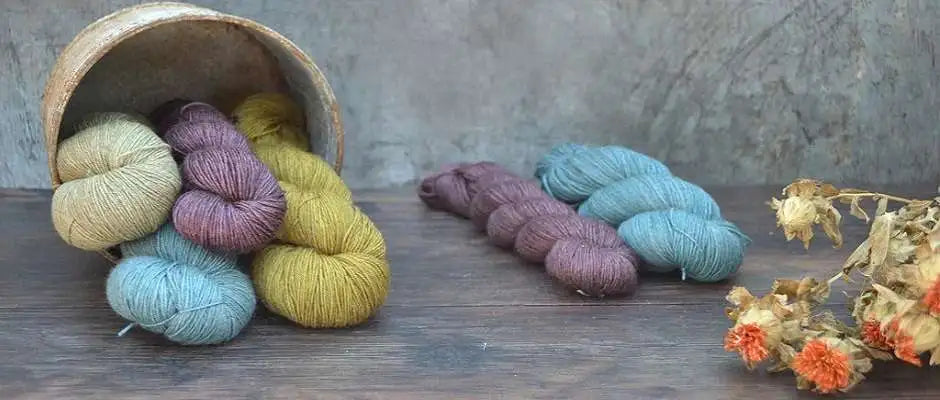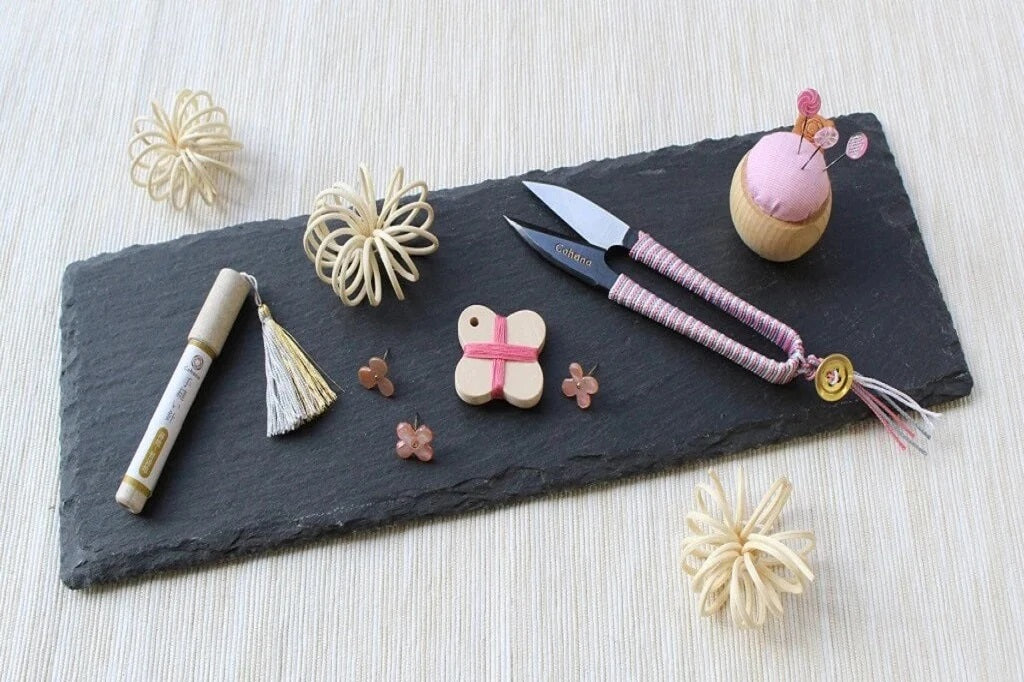History of Natural Dyes
Natural Dyeing History
There are two types of dyes, Natural Dyes and Synthetic Dyes. Natural dyes are derived from animal or plant sources while synthetic dyes are manmade chemicals. Prior to 1856, the only dyes available were natural dyes. In 1856, the first synthetic dye was made and from that time, the synthetic dye industry was created. Today if you wish to dye anything, you have the choice between natural and synthetic dyes.
Natural Dyes and FelinFach
We only use natural dyes to dye our hand dyed yarn. Our yarn is dyed in small batches in Pembrokeshire, Wales and with natural dyes only. We also offer Craft Courses and Workshops in Pembrokeshire on natural dyeing wool and other fabrics with natural dyes only.

Ancient Times: The Origins of Natural Dyeing
Natural dyes have been used by our ancestors for thousands of years to colour fibres, fabrics, and other materials. The history of natural dyes can be traced back to the earliest civilisations, where plants, insects, and minerals were used to create a variety of colours. Over time, the art of dyeing with natural dyes has evolved and transformed, reflecting changes in culture, technology, and the environment.
The use of natural dyes dates back thousands of years, with evidence of their use found in archaeological sites around the world. Some of the earliest evidence of natural dyes can be traced back to prehistoric times, where remnants of dyed fibres have been found in caves and ancient settlements.
Egypt and China
Archaeological findings from various regions provide insights into the early use of natural dyes. For example, in ancient Egypt, evidence of dyed textiles has been found in tombs and burial sites, including fragments of linen and wool dyed with plant-based dyes such as indigo, madder, and safflower. Similarly, in ancient China, dyed silk textiles have been discovered in tombs dating back to the Han Dynasty (202 BC - 220 AD), with evidence of the use of plant-based dyes such as indigo and woad.
South America
In South America, ancient Peruvian textiles dating back to around 2500 BC have been found with traces of natural dyes, including the use of plant-based dyes such as cochineal, annatto, and various local plant species. In other regions such as India, Japan, and Central Asia, historical records and artifacts also indicate the use of natural dyes for textile colouring, with evidence of plant-based dyes, as well as animal and mineral-based dyes.
In addition to plants, insects were identified as a source of natural dyes. For example, cochineal, a red dye derived from dried insects, was discovered by the ancient Maya and Aztecs in Central and South America to create vibrant red and pink hues in their textiles.
Europe
The use of natural dyes in Europe can be traced back to ancient civilizations such as the Greeks, Romans, and Celts. Plant-based dyes were commonly used, with sources such as madder (Rubia tinctorum) for reds, woad (Isatis tinctoria) for blues, and weld (Reseda luteola) for yellows.
Texts and Manuscripts
Ancient texts and manuscripts from different civilisations also provide documentation of natural dyeing techniques and recipes. For example, the "Mappae Clavicula," a medieval Latin manuscript from the 9th century, contains instructions for dyeing with plant-based dyes. The "Shen Nong Ben Cao Jing," a Chinese pharmacopoeia written around 100 AD, also includes descriptions of various plants used for dyeing.
Middle Ages and Renaissance: The Rise of Trade and Guilds
During the Middle Ages and Renaissance, the use of natural dyes expanded as trade routes expanded, and the demand for colourful textiles grew. Dyeing became a specialised craft, and new guilds started to regulate and protect the trade.
One of the most significant developments during this period was the discovery of new sources of natural dyes. For example, the arrival of the New World to Europe in the late 15th century brought about the introduction of new natural dyes, such as logwood and cochineal, which were highly prized for their vibrant colours.
The use of natural dyes during this period was also closely linked to the development of textile centres, such as Flanders, Italy, and England, where specialised dyers and weavers produced exquisite textiles using natural dyes. Textile trade and the use of natural dyes became an important part of the economy, and the knowledge of dyeing techniques and recipes were closely guarded secrets within the guilds.
Industrial Revolution: The Decline of Natural Dyeing
The industrial revolution in the 18th and 19th centuries brought about significant changes in the textile industry, including the invention of synthetic dyes. Synthetic dyes, which were cheaper and more easily produced than natural dyes, rapidly gained popularity and replaced natural dyes in many textile applications.
As the use of synthetic dyes increase, there was an equivalent decline in the use of natural dyes. The focus shifted towards mass production and uniformity in colour. Natural dyeing became largely relegated to small-scale production, local crafts, and traditional cultural practices in certain regions of the world.
Synthetic Dye Invented
An English chemist named William Henry Perkin in 1856 invented the first synthetic dye. At the age of 18, Perkin was attempting to synthesise quinine, a medication used to treat malaria, from coal tar as part of his research. However, instead of obtaining quinine, Perkin accidentally discovered a purple dye, which he named mauveine.
Perkin's discovery of mauveine marked the birth of the synthetic dye industry, as it was the first time a dye had been created through chemical synthesis rather than being extracted from natural sources. Mauveine was commercially produced and quickly gained popularity as a vibrant and stable dye that could be used to colour textiles, clothing, and other materials. This breakthrough paved the way for the development of many other synthetic dyes, leading to the growth of the modern chemical and textile industries.
The invention of synthetic dyes revolutionised the textile industry, as it allowed for a wide range of colours to be produced in a more consistent and affordable manner compared to natural dyes. Synthetic dyes quickly replaced natural dyes in many textile applications due to their versatility, stability, and cost-effectiveness. However, concerns about the environmental impact and health effects of synthetic dyes have led to a renewed interest in natural dyes in recent years, and the use of both synthetic and natural dyes continues to coexist in the textile industry today.
Hand Dyed Yarns with Natural Dyes at FelinFach
All yarn at FelinFach is hand dyed yarn, dyed in small batches in Pembrokeshire, Wales and with natural dyes only.
Revival of Natural Dyes: The Modern Era
Environmental Concerns with Synthetic Dyes
One of the main drivers of the revival of natural dyes is their eco-friendly and sustainable nature. Synthetic dyes are often derived from petrochemicals and can have negative environmental impacts, such as pollution of waterways and soil, energy-intensive production processes, and hazardous waste generation. In contrast, natural dyes are derived from renewable sources such as plants, insects, and minerals, and their production processes are generally considered to be more environmentally friendly and biodegradable.
Furthermore, natural dyes are often perceived as safer and healthier compared to synthetic dyes, as they do not contain harmful chemicals such as heavy metals or carcinogenic compounds. This makes natural dyes a popular choice for those who are concerned about the potential health risks associated with synthetic dyes, including artisans, craftspeople, and consumers.
Consumer Desire for Unique Products
Another factor driving the revival of natural dyes is the desire for unique and authentic products. Natural dyes often produce subtle, nuanced, and variable colours that are appreciated for their natural beauty and individuality. This is in contrast to synthetic dyes, which can produce uniform and predictable colours. The use of natural dyes allows for creative experimentation and customisation, leading to the creation of one-of-a-kind textiles, fashion items, and artworks that are highly valued by those seeking unique and meaningful products.
The revival of natural dyes has also been supported by advancements in research and technology. Scientists, researchers, and artisans have been exploring and experimenting with natural dye sources, dye extraction methods, and dyeing techniques, leading to innovations in natural dyeing processes and expanding the color palette of natural dyes. Additionally, there has been an increased focus on education, workshops, and community initiatives to promote awareness and knowledge about natural dyes among practitioners, consumers, and the general public.
Natural Dyes Today
Today, the revival of natural dyes can be seen in various applications, including fashion, textiles, home goods, art, and crafts. Many artisans, designers, and brands are incorporating natural dyes into their products, creating a niche market for sustainable and authentic goods. Consumers are also increasingly seeking out products made with natural dyes as a way to support eco-friendly practices and reconnect with traditional and cultural heritage.
About FelinFach
Located in Pembrokeshire Wales, our ethos is defined in the three words...
NATURAL TRADITIONAL HANDMADE.
- Hand woven iconic Welsh blankets.
- Hand dyed yarn, dyed with natural dyes only - no exceptions!
- Hand poured candles, candle accessories and Candle Making Workshops.
- Natural Dyeing Craft courses.
- Yarn shop, yarn bowls, project bags, tools and accessories for knitters and crafters.
- Welsh Gifts, souvenirs, made in Wales, handmade in Wales.
We are a proud supporter of Americymru, the Campaign for Wool, Global Welsh and Red Dragon America.
Other FelinFach Pages
Last updated 12th February 2025
























